My beautiful friend Katie sent me an email a few weeks ago suggesting that I make and write a post about Pizzagaina, the Italian meat and cheese pie traditionally eaten on Easter Sunday to celebrate the resurrection of Jesus and the gift of salvation. As soon as I got her message, I agreed because Pizzagaina is an AMAZING dish that can be enjoyed by all regardless of nationality or religion (just ask my Jewish Ukrainian husband who has been eating it daily for the past week!).
Filled to the brim with a variety of meats, eggs, and cheese, it's truly a celebratory dish that stands in marked contrast to the more modest meals traditionally consumed during the previous 40 days of fasting and sacrifice (Lent). It's definitely not an everyday dish, but rather one that is meant to be enjoyed during this joyful season, in the company of friends and family.
First, a little language lesson: The name Pizzagaina (pronounced "pizza jay-nah") is actually an Italian American adaptation of the original name Pizza Chena, which in itself is Neapolitan dialect for "full pie." The pie is also known in some families as "Pizza Piena" (piena meaning "full" in standard Italian) or simply Italian Easter Ham Pie. Those of you who also speak Spanish, will recognize the similarity to the Spanish word for full, which is "llena."
Apart from the different names, there are as many variations of this dish as there are Italian families. Some families prefer a chewy, bread-like crust, while others go with a more standard, flaky pie crust. Some people layer their meat in sliced, while others used diced cubes. The variety of meats and cheese can also vary depending on tastes and availability. The recipe that I give you here is by no means meant to be the definitive version; but it's a good basic version, which produces a stellar pie, and which will still allow you to customize it as you'd like. Below I've added my notes and recommendations on each aspect of the dish, along with suggestions for making it your own based on your budget, tastes, and what's available in your neighborhood.
The Crust: I recommend a standard yeasted pizza dough crust, which is easy to work with and stands up well to the heavy filling. I provide directions for making your dough from scratch, but if you prefer, you can also use premade pizza dough purchased from the freezer section of the grocery store or even bought directly from your local pizza parlor (a lot of places will sell you a couple pounds of their dough if you just ask).
If you want a flaky dough, simply use an equivalent amount of your favorite pie crust. (If you opt for the latter, you can top the pie with a lattice crust or even add a decorative cross with extra dough on top of the top crust.)
The Meat Filling: You're going to need about 2 pounds of a variety of meats. The choice is totally up to you. I used about a 1/4 pound each of Genoa salami, pepperoni, capicolla, hot soppressata, and a 1/2 pound each of Black Forest ham and mortadella. Feel free to pick your favorites or go by what's on sale or available in your neighborhood. If you'd like, you can also use a portion of cooked hot Italian sausage (out of the casing) to make up the 2 pounds.
One thing I definitely recommend is to use a combination of both mild (like ham and mortadella) and heavily spiced (like capicolla and pepperoni) for a more interesting and balanced flavor. Traditionally, this dish is made with pork products, but I'm sure cured beef like bresaola or bastirma would also work nicely. Depending on your budget and what is available to you, you can also get creative and use things like Taylor ham (pork roll) or diced smoked sausage.
The Cheese: Traditionally, Pizzagaina is made with an Italian cheese called "basket cheese" (also "Easter Cheese"). This cheese is often sold in regular grocery stores in neighborhoods with a high Italian-American population (like where I grew up in New Jersey) and Italian specialty stores everywhere else. It is named because of the way it is made and sold, inside a little basket. The cheese itself is very mild, and used as a binder in recipes like this one. As this can be difficult to find, you can simply use ricotta (preferably fresh) as an easy substitute. Other possible options include
farmer's cheese, mascarpone, or quark.
For the sliced cheese, I use a 1/2 pound each of mozzarella and provolone (I like the latter because it adds a little sharpness to the mix). As this is such a heavy wet dish, I recommend using either a dryer mozzarella (one that doesn't come packed in water), or fresh mozzarella that you've allowed to drain for a few minutes before slicing. Do not use mozzarella di buffala or burrata. You can also replace a portion of the sliced cheese with grated parmigiano or pecorino, and mix that into the egg filling.
Finally, the baking dish: I make my pizza in a round springform pan with high 3" sides. I like that this pan allows you to easily release it from the mold once it's cooled so that you can serve on a pretty platter. You can also bake this in a square or rectangular baking dish and simply serve it in the pan. Once again, the choice is totally up to you!
Oh and one last thing! Once you follow this recipe, you'll see that essentially what you're making is a filled loaf of bread. A technique which can easily be adapted to other (and perhaps slightly healthier) variations. You could, for example, make a vegetarian version that replaces the meat with a variety of grilled vegetables, or stir in some savory sauces like pesto or tapenade for additional flavor. Or you can use a variety of ground meats. The possibilities are really endless; I hope that you find this recipe just as inspiring as I do!
P.S. Want to see more step-by-step photos? Visit the pizzagaina photo album I posted on the Always Order Dessert Facebook page, and feel free to leave any questions you may have about this recipe (or any other!) on the wall, and I'll get back to you right away! xo
****
New to Always Order Dessert? Consider subscribing to my RSS feed, follow me on Twitter, become a fan on Facebook, or sign up to receive my once-a-week e-mail updates by filling in your address in the box on the right. And if you ever need any entertaining or cooking advice, please don't hesitate to e-mail me. Thanks for reading!
Pizzagaina (Pizza Chena, Italian Easter Pie)
Serves 12-14; If you'd prefer, you can simplify this dish even further by using pre-made pizza dough for this recipe (you'll need 2 pounds), or for a flaky crust, substitute your favorite pie crust recipe and proceed from there.
Dough
2 1/2 teaspoons active dry yeast (1 packet)
1 tablespoon granulated white sugar
2 cups warm water (about 115 degrees F)
1 tablespoon Kosher salt
6-8 cups all-purpose flour
3 tablespoons olive oil, plus more for greasing bowl
Filling
13 large eggs
2 pounds of a variety of your choice of Italian charcuterie/salumi (such as genoa salami, mortadella, capicolla, pepperoni, ham, prosciutto, soppressata, etc.)
1 teaspoon ground black pepper
1 pound fresh ricotta or Italian basket cheese
1/2 pound mozzarella cheese, thinly sliced
1/2 pound provolone cheese, thinly sliced
Equipment: One 10" by 3" round springform pan (A 9x3" springform will also work, but you may have a little extra filling or dough leftover)
Directions
First make the dough:
In the base of a stand mixer, combine 1 package of active dry yeast with 1 tablespoon sugar and 2 cups warm water. Whisk well to dissolve and let stand 2 minutes.
Add the tablespoon of Kosher salt and 6 cups of all-purpose flour, to start. Use the dough hook on your mixer to mix together, increasing speed as the flour is incorporated and a dough starts to form. Add the olive oil, and continue to knead at high speed in the mixer, adding more flour 1/4 cup at a time until the dough is smooth, springy, and not sticky. The dough should form a kind of a tornado within the mixer as it kneads--coming away from the sides entirely, but still connected to the bottom. If it still sticks to the sides of the bowl, add more flour. If it comes off the sides and bottom completely, add an extra tablespoon or two of water. Let knead in the mixer for 5 minutes.
Prepare a large clean glass or metal bowl by drizzling olive oil in the bottom.
The dough with be smooth and able to be handled when ready. Remove the dough from the mixer and form into a smooth ball. Place into the oiled bowl, turning once so that the oil coats the top and bottom. Cover bowl loosely with plastic wrap and place in a warm, draft-free place to rise until doubled in size--about 2 hours. [Note: I always place my rising dough inside my (turned off) oven, allowing just the heat from the pilot light to keep it warm. Other good spots are inside a (turned off) microwave.]
Prepare the filling:
Make four hardboiled eggs by placing 4 uncooked eggs in a small saucepan and covering with tap water . Place over high heat and bring to a boil. Let boil for 1 minute, then turn off heat, cover pot, and let sit for 10-15 minutes. Drain out the hot water and replace with cold water, letting the eggs cool for 5 minutes. Tap the eggs against the counter and peel. Slice each egg and set aside.
Prepare the meat by stacking the various meats into small piles, and using a sharp knife to dice into 1/2-1" size pieces. Set aside.
In a large bowl, whisk 8 large eggs well until frothy. Whisk in the black pepper and the ricotta or basket cheese until well combined. Use a wooden spoon or spatula to gently stir in all of the cut meat pieces, mixing until all are evenly distributed. Set aside.
Assemble:
Preheat your oven to 350 degrees F, and grease the inside of your springform pan with olive oil or nonstick baking spray.
Once the dough has risen, poke it down to release the air bubbles. Sprinkle some flour on a clean work space, and transfer the dough to the floured surface. Cut the dough in half, returning one half to the bowl, and focus on the other half. Shape into a ball, and then use a rolling pin to roll out the dough into a large round (about 11 or 12 inches in diameter). If the dough keeps shrinking back, let it rest for a few minutes before trying it again.
Gently fit the rolled out dough over and into the prepared springform pan, tucking it into all sides. The dough should overhang about 1 to 2 inches around the top.
Use a large spoon to pour in about 1/3 of the egg and meat filling, spreading it evenly. Top with about 1/3 of the sliced eggs and 1/3 of the sliced mozzarella and provolone cheeses. Continue in this order until all the filling, eggs, and cheese have been added (or until the filling reaches the top if you're using a smaller pan).
Grab the second half of the dough and place on the floured work surface, and roll out a second 10-12" round. Lift this dough round over the filled pan and cover it entirely. The dough should overhang about 1" on all sides. Use a knife or kitchen shears to trim off anything longer than 1", and then pinch together the top and bottom doughs well until sealed, then roll up evenly around the pan to create a rim.
Whisk the final egg in a small bowl along with a 1/4 cup of water. Use a pastry brush to brush the egg wash over the entire pie.
Bake in your preheated 350 degree oven for 60 to 70 minutes, or until the crust is golden brown. Remove from the oven and let cool in the pan for 30 minutes before releasing the spring and removing the outside ring. Transfer to a serving plate and let cool completely. Can be enjoyed the same day, or chilled up to 2 nights in the fridge before serving cold or at room temperature.
Pizza can be stored in an air-tight container in the fridge for up to one week, or slices can be individually wrapped and frozen.

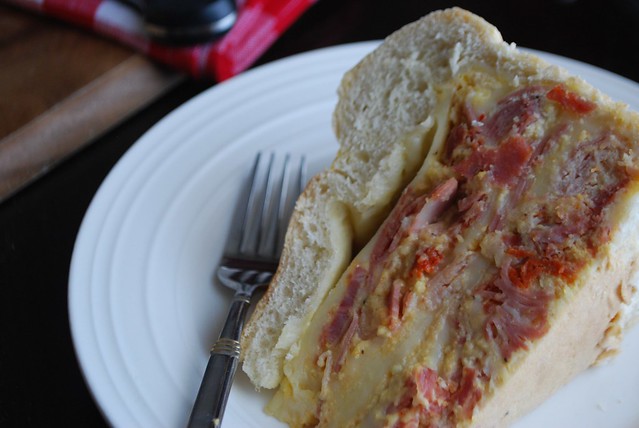
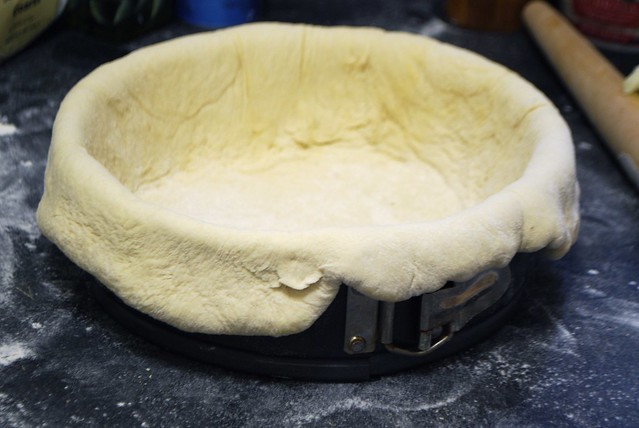
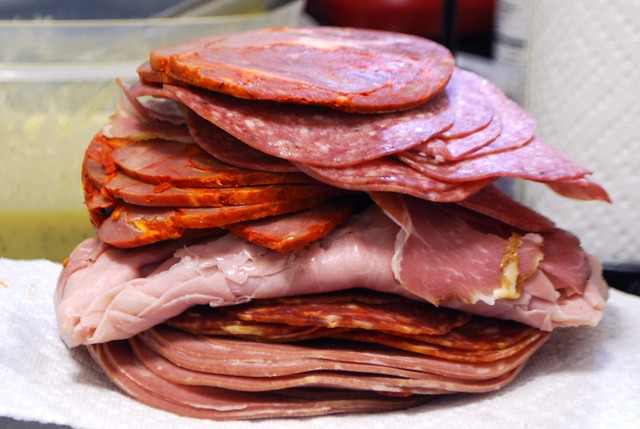
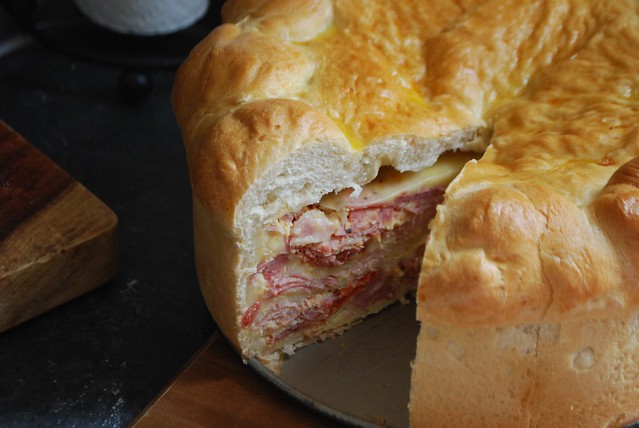
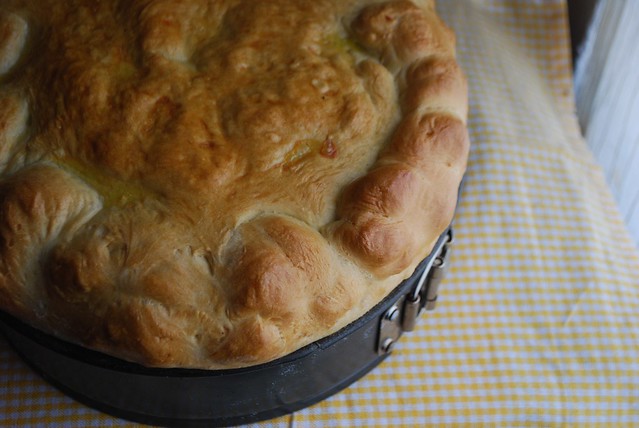
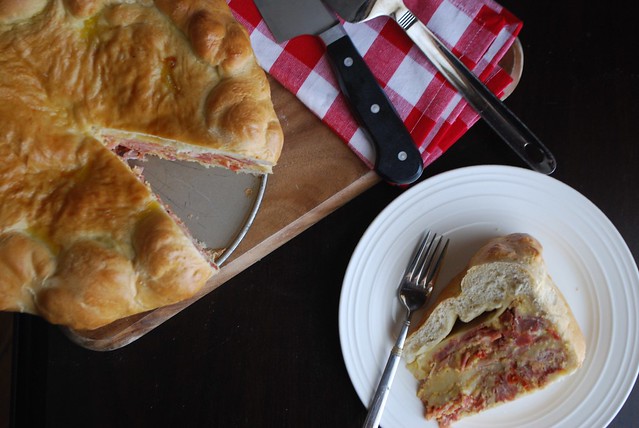


No comments
Hi there and thank you for reading! This blog is not currently active, so new questions are not being monitored. Please enjoy the archives.
Note: Only a member of this blog may post a comment.